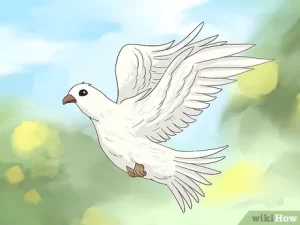
The fundamentals of making balloon animals
1. Inflating your balloon
The first crucial step is to inflate your balloon. You can use an air pump to do this but it’s crucial you leave some of the balloon unfilled. If you pump your balloon all the way up and attempt to twist it may pop. Leave one inch uninflated no matter what your design is. This will give the air in the balloon room to move and you the ability to twist and knot it.
2. How to make a basic twist
Hold your balloon with one hand and grip further down the balloon with the other. Turn your hands away from one another to create a twist. Keep hold of the balloon to prevent it untwisting. Keep twisting parts of the balloon depending on how many segments you need. It’s as simple as it looks!
3. How to make a lock twist
A lock twist is crucial in balloon making. It allows you to twist different balloon segments together firmly to make your animal’s body parts. Make four basic twist segments, fold two of them together and twist. Make sure you twist them two or three times so they’re securely fixed together.
4. How to make a fold twist
Finally, you need to master the fold twist. This twist is made the same way as a lock twist is except the balloon segments begin further away. For a lock twist, you twist two adjoining segments together for a tight twist. For a fold twist create three longer basic twist segments. Then twist the first and last segment together. The middle segment will now curve and form a loop. This is your fold twist. You’ve now created an ear for a little dog!
What do I need to make balloon animals?
Now you have the basic techniques you need to buy your supplies! All you need is a balloon pump and some balloons.
Balloon pump
You do really need a pump (as anyone who has tried blowing up modelling balloons without one can testify) but they’re inexpensive and if you get the right one they’ll last you ages. It’s definitely worth investing in a pump that’s not the cheapest out there.I’ve learnt this the hard way and broken two bargain pumps within minutes before I clocked that it might be a good investment to spend a bit more on hardware that would last. I should add, that they’re still really not very expensive.**Buy it now:**Magnolia Balloon Inflator Hand Pump (£6.49 Amazon)
Balloons
There are various sizes of modelling balloons out there, and they come with a number that refers to the size of their diameter and length once inflated. The most common size for twisting is 260 – which means 2 x 60inches.I’ve never used this measurement when buying balloons – either in person in a party shop or online – I just buy a pack of modelling balloons and hey presto they do the trick.It’s always worth doing a practice run of any balloon animal tutorial to check how it works with the balloons you’re working with. After a dummy run, you’ll soon see if the instructions may need adjusting slightly to suit the length of your balloon – you’ll spot pretty quickly if you end up with an extra-long tail or run out of the balloon to twist.If this happens, simply untwist or try again with a fresh balloon and adjust the length of the different sections of the balloon that you twist accordingly.**Buy it now:**200 modelling balloons (Amazon, £10.18) **Buy it now:**260 colourful modelling balloons (Amazon, £8.99)
Get started with a balloon animal starter kit
If you want to combine, stock up on all the supplies you need to see you through parties for years with these kits which combine the pump and balloons…**Buy it now:**Balloon Animal Starter Kit (£23.90, Amazon) **Buy it now:**Deluxe Balloon Animal Kit (£27.80, Amazon)
How to make four different balloon animals
Here are 4 easy balloon animals to try to learn how it’s done:
- Dog
- Inflate a 260 balloon, leaving 1 inch uninflated
- Make a basic twist 3 inches from the end to create the head
- Make a lock twist 3 inches down for the neck
- Make 2 basic twists for the front legs, lock twist to the body
- Make 2 basic twists for the back legs, lock twist to the body
- Make 2 basic twists for the tail, lock twist to the back
- Pinch the muzzle and tie off with a small twist
- Pinch the ears and tie off with small twists
- Sword
- Inflate a 260 balloon, leaving 1 inch uninflated
- Make a basic twist 3 inches from the end for the handle
- Make a basic twist 6 inches down for the guard
- Make a basic twist 12 inches down for the blade
- Fold the blade in half and lock twist to the guard
- Flower
- Inflate a 160 balloon, leaving 1 inch uninflated
- Make a basic twist 3 inches from the end for the stem
- Make a basic twist 3 inches down for the first petal
- Make 5 more basic twists for the remaining petals
- Pinch the petals and tie off with small twists
- Butterfly
- Inflate a 160 balloon, leaving 1 inch uninflated
- Make a basic twist 3 inches from the end for the body
- Make a basic twist 3 inches down for the first wing
- Make a basic twist 3 inches down for the second wing
- Pinch the wings and tie off with small twists
FAQ
What size balloons are best for beginners?
260 balloons are the most common size for beginners. They are long enough to create most basic balloon animals but not too long to be difficult to control.
How do I tie off the end of a balloon?
To tie off the end of a balloon, simply pinch the uninflated end between your thumb and forefinger. Wrap the inflated part of the balloon around your fingers a few times and tuck the end under the wrapped part. This will hold the air in and keep the balloon tied off.
What if my balloon pops while I’m twisting?
If your balloon pops while you’re twisting, simply start over with a new balloon. It takes practice to learn how much to inflate the balloon and how to twist without popping it. Don’t get discouraged, popping balloons is a normal part of learning.
How do I make the balloon stay in the shape I twisted it into?
The balloon will naturally hold its twisted shape for a while, but to make it last longer, twist the balloon segments tightly and securely. The tighter the twists, the longer the balloon will hold its shape. You can also use a lock twist to connect segments and keep them in place.
What if my balloon keeps untwisting?
If your balloon keeps untwisting, try twisting the segments a few more times to lock them in place. You can also try using a lock twist to connect segments. Make sure you are twisting the balloon tightly. If it still won’t hold its shape, start over with a new balloon.
How do I clean my balloon pump?
To clean your balloon pump, wipe it down with a damp cloth after each use. If the pump gets clogged, you can blow air through it backwards to clear it out. Avoid getting the pump wet or submerging it in water.
Can I use regular balloons instead of modelling balloons?
While you can use regular round balloons, modelling balloons are specifically designed to be twisted and hold their shape better. Modelling balloons are usually made of a thicker latex and come in long skinny shapes ideal for twisting. Regular balloons are more prone to popping and untwisting.
How do I store my balloon animals?
To store your balloon animals, keep them in a cool, dry place out of direct sunlight. Avoid storing them in extreme heat or cold. You can display them in a clear container or hang them from strings. With proper storage, balloon animals can last for several days.
Can I use a helium tank to inflate my balloons?
While you can use helium to inflate balloons, it’s not necessary for balloon twisting. Helium is expensive and balloon animals are too heavy to float anyway. Regular air from a pump or your own breath works just fine for inflating balloons for twisting.
How do I learn more advanced balloon twisting?
To learn more advanced balloon twisting, look for in-person classes or workshops in your area. Many party supply stores, magic shops, and clown organizations offer balloon twisting lessons. You can also find online tutorials and books to learn new techniques and designs. Keep practicing the basics and experiment with different balloon sizes and shapes.
| Year | Named Storms | Hurricanes | Major Hurricanes | ACE |
|---|---|---|---|---|
| 1851 | 6 | 3 | 1 | 36 |
| 1852 | 5 | 5 | 1 | 73 |
| 1853 | 8 | 4 | 2 | 76 |
| 1854 | 5 | 3 | 1 | 31 |
| 1855 | 5 | 4 | 1 | 18 |
| 1856 | 6 | 4 | 2 | 49 |
| 1857 | 4 | 3 | 0 | 40 |
| 1858 | 6 | 6 | 0 | 45 |
| 1859 | 8 | 7 | 1 | 56 |
| 1860 | 7 | 6 | 1 | 62 |
| 1861 | 8 | 6 | 0 | 50 |
| 1862 | 6 | 3 | 0 | 46 |
| 1863 | 9 | 5 | 0 | 50 |
| 1864 | 5 | 3 | 0 | 27 |
| 1865 | 7 | 3 | 0 | 49 |
| 1866 | 7 | 6 | 1 | 84 |
| 1867 | 9 | 7 | 1 | 60 |
| 1868 | 4 | 3 | 0 | 35 |
| 1869 | 10 | 7 | 1 | 51 |
| 1870 | 11 | 10 | 2 | 88 |
| 1871 | 8 | 6 | 2 | 88 |
| 1872 | 5 | 4 | 0 | 65 |
| 1873 | 5 | 3 | 2 | 69 |
| 1874 | 7 | 4 | 0 | 47 |
| 1875 | 6 | 5 | 1 | 72 |
| 1876 | 5 | 4 | 2 | 57 |
| 1877 | 8 | 3 | 1 | 73 |
| 1878 | 12 | 10 | 2 | 181 |
| 1879 | 8 | 6 | 2 | 64 |
| 1880 | 11 | 9 | 2 | 131 |
| 1881 | 7 | 4 | 0 | 59 |
| 1882 | 6 | 4 | 2 | 59 |
| 1883 | 4 | 3 | 2 | 67 |
| 1884 | 4 | 4 | 1 | 72 |
| 1885 | 8 | 6 | 0 | 58 |
| 1886 | 12 | 10 | 4 | 166 |
| 1887 | 19 | 11 | 2 | 181 |
| 1888 | 9 | 6 | 2 | 85 |
| 1889 | 9 | 6 | 0 | 104 |
| 1890 | 4 | 2 | 1 | 33 |
| 1891 | 10 | 7 | 1 | 116 |
| 1892 | 9 | 5 | 0 | 116 |
| … | 1938 | 9 | 4 | 2 |
Source: NOAA/AOML Hurricane FAQ


